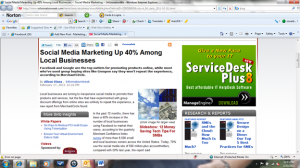Years ago when I first started working in marketing and promotions mobile marketing meant literally a mobile event, often a truck or promotional vehicle. I worked on many of these traveling exhibits that delivered an interactive experience for the consumer. We handed out samples, supported PR events and delivered unique and interesting experiences for the consumer to engage in the brand. Those in experiential marketing may still consider this mobile marketing. To the new generation of marketers it means something else entirely. To them, mobile marketing means the use of mobile devices such as IPhones, Smart Phones and tablet PC’s in marketing efforts.
Blog Posts
When I get the chance I like to highlight great examples in the area of integrated marketing. One I recently have come across is a new brand relaunch campaign for Keds footwear. In an attempt to revitalize their brand and make them hip to the 18-24 year old demographic they have pulled all the pieces together, integrated multiple relevant touch points and did it methodically over multiple years to grow interest.
Recently, I have started “friending” some of my favorite local stores that I go to repeatedly. I had been slow to the practice wondering what the point was (I am not one of those early adopters), but have discovered that I like seeing the updates of the “special of the week” or announcement of a big store event. Whenever my favorite gourmet cheese shop downtown posts the special cheese they are sampling it often gets me into the store to try it and ultimately buy it. I used to get all of these via email, but find I like the Facebook announcements. So, what does this say about social media and how local businesses use it?
In this recent article businesses indicated that they are increasing their use of Facebook, but other sites such as Groupon, Foursquare and Living Social are not being used to their full potential. (Click on image to go to article)
Additionally, the survey indicates that consumers do react to local deals and information to drive them into the store (just like I do). What then is the disconnect between consumer behavior and retailer marketing methods?
What I have encountered speaking with local retailers as well as small local businesses such as real estate agents and consultants is they just don’t know what these vehicles are or how to use them. They don’t have any real money to spend and are fearful of taking the leap. What’s more, they are all really concerned about the time it will take to utilize things like Twitter, blogging and online offers and they claim lots of technology ignorance.
There are always early adopters both from a marketers and a consumer standpoint. Those that fall into this early adopter camp take the biggest risk, but also can reap the biggest rewards. The younger generation is more likely to try the new technology especially mobile marketing and these are often the ones who are spending the bucks. Moreover, it appears based on some recent research that fewer and fewer of this younger set are using email, thus, making email blasts potentially obsolete. They use texting or email on Facebook instead so you need to talk to them where they consume the media.
If Twitter and Facebook are getting more of the lion share of local online marketing it is most likely because they are low-cost (free), easy to master and part of our daily vernacular.
When I speak to these small retailers and small businesses I use a variety of techniques to get them into the modern age to use social media to grow their businesses.
- Help them get over their fears: Not easy, but it is a matter of not just explaining how things work, but actually demonstrating the ease and speed with which these things can be done. Share some data on success stories and survey data and they will be more easily swayed.
- Provide a reasonable timeline: Building a large enough database through viral marketing techniques takes time. Even if they use their email list to drive more eyes to the offers it will take a while for those other than the early adopters to start acting. Don’t expect an immediate response.
- Test Offers: Building on the “it takes time” idea, the first offer doesn’t always work. It often takes a few different offers until you find the one that will resonate with consumers and drives them to purchase. Keep trying until one gets the ROI they want.
- Start Slow and Add On: If the business is entering social media for the first time they should start slow and get comfortable. Most likely they have a website. Start by adding Facebook and Twitter and connecting to the website. Get them familiar with the vehicles and then slowly add on additional offer sites. Balance it with some SEO and paid search at a local level where they are more open to spending. Then test replacing a direct mail piece with an online offer. Show the potential ROI of doing the social media over the direct mail. It will probably be very eye opening for them.
Eventually, from a retail perspective it all comes down to customer service, product offerings in store and the economy. Do those things right and you have a great chance to succeed. Additionally, if local retailers then leverage emerging social media marketing tactics as a way to drive growth on top of the basics they are more likely to increase their success.
Would love to hear of examples of how social media has driven local retailer success.
On a recent post on Promomagazine.com where agencies provided solutions to client problems, they asked how companies can restructure themselves to best support integrated marketing initiatives. While the answer given was dead on, the bigger question facing both agencies and their clients is, how do you best manage integrated marketing and promotions even as companies continue to downsize or eliminate marketing services departments altogether?
 More and more companies rely on their brand teams to manage all aspects of the marketing mix, including PR, promotions, advertising and digital. These already overworked brand managers and directors are being asked to manage and communicate daily with each of their agency partners without any additional expert resources to help guide them or relieve the burden. This can be a daunting task when you consider the possibility of separate agencies for consumer promotions, advertising, PR, customer marketing, digital and packaging. If the brand managers spend so much time managing these agencies, when can they actually manage their business? This pressure to do more with less ultimately burns out brand teams, hampers good client/agency communication and puts more emphasis on outsourcing activities to the agency partners.
More and more companies rely on their brand teams to manage all aspects of the marketing mix, including PR, promotions, advertising and digital. These already overworked brand managers and directors are being asked to manage and communicate daily with each of their agency partners without any additional expert resources to help guide them or relieve the burden. This can be a daunting task when you consider the possibility of separate agencies for consumer promotions, advertising, PR, customer marketing, digital and packaging. If the brand managers spend so much time managing these agencies, when can they actually manage their business? This pressure to do more with less ultimately burns out brand teams, hampers good client/agency communication and puts more emphasis on outsourcing activities to the agency partners.
As more emphasis is placed on the agencies, the lack of knowledgeable internal client representatives makes it difficult for those agencies to manage programs efficiently. Agency partners want clear concise direction, and since they operate on tight budgets, they are often frustrated by the confusion, rework and misdirection that can result without the internal client expertise they prefer to have.
Even if the economy improves, it will not necessarily equate to more hiring in the marketing services specialties on the client side. Those companies that are not structured for marketing service departments or have cut back significantly are not likely to go back to having a larger department or adding one. They have made a philosophical change in how they manage their marketing department, or decided they can live without the department altogether and continue to outsource more to their agencies.
What then is the solution? I have a few ideas, especially assuming the downsizing of marketing services departments is here for the long haul. These same approaches also can be used by smaller, growing companies that are not ready for added staff to handle these areas.
1) Train Your Staff: Consumer promotions, PR, digital, etc. are all unique disciplines that require a certain level of expertise to manage them effectively. Unfortunately, these disciplines are not generally taught within a traditional MBA curriculum, and while an associate brand manager learns by doing on the job, he or she needs guidance and training.  Hire an outside consultant or use your agencies to do some internal training – Promotions 101, Digital 101, Social Media 101 – to give your staff a basic knowledge of the disciplines and provide benchmarks for future activities. Continue the training with more in-depth and specialized topics to build the expertise. Knowing what to question and how to challenge agency plans and budgets only comes from ongoing experience and knowledge, and that questioning and challenging will lead to a more efficient agency spend.
Hire an outside consultant or use your agencies to do some internal training – Promotions 101, Digital 101, Social Media 101 – to give your staff a basic knowledge of the disciplines and provide benchmarks for future activities. Continue the training with more in-depth and specialized topics to build the expertise. Knowing what to question and how to challenge agency plans and budgets only comes from ongoing experience and knowledge, and that questioning and challenging will lead to a more efficient agency spend.
2) View the Agency as Your Partner: Agencies prefer to be a part of the initial planning and strategy development and not just handed an RFP to do the work. This earlier involvement benefits all parties because it means less interpretation of an RFP, clearer communication and more commitment from the agency. In the Promo Magazine article, it was mentioned that having a clear process is important in effective integrated marketing initiatives. It becomes even more important when you don’t have an internal team dedicated to solely managing this process. By making the agency a partner in this, you can relieve some of the burden from your team because the external team is vested in the success of the plan from the onset.
3) Require detailed execution plans from the agencies: It means more work for your partners, but will make the process easier for the internal client team. Instead of the magic behind the curtain, you will understand what each step of the process will be and enable the internal team to do a better job of managing the checks and balances associated with the program execution. It will also make it easier for the agency partner in the long run since they will have a client with realistic expectations. Unrealistic expectations are rampant when the client lacks the knowledge and expertise they need to manage the agency partner.
In the end, best practice says clients should retain at least one internal marketing services expert to help provide guidance and internal consulting. Companies do not always believe in this practice or are unable to allocate funds for this role. When they don’t, the above ways can help their marketing teams work better with their agencies and create efficient and effective programs.

